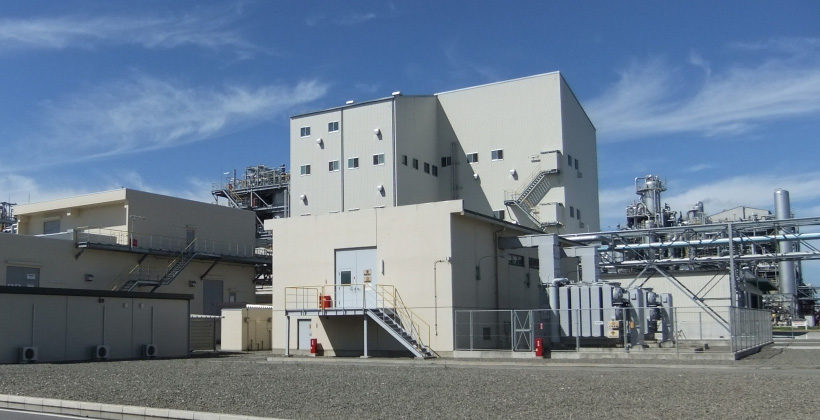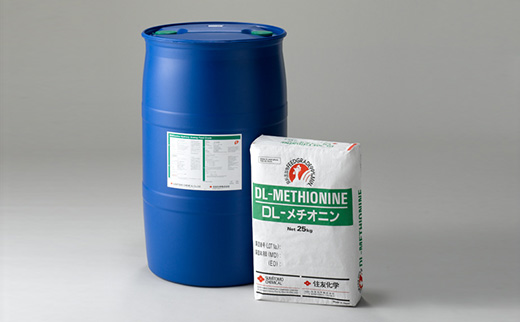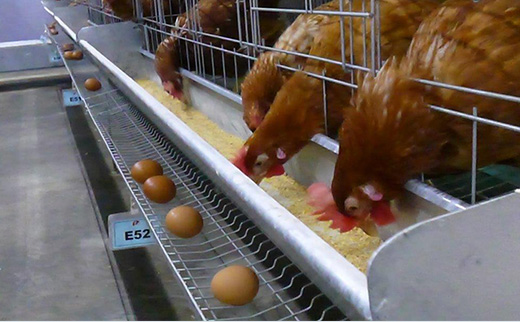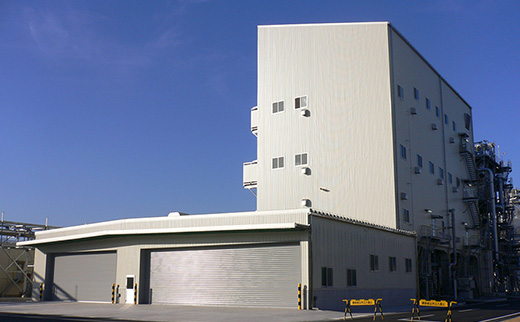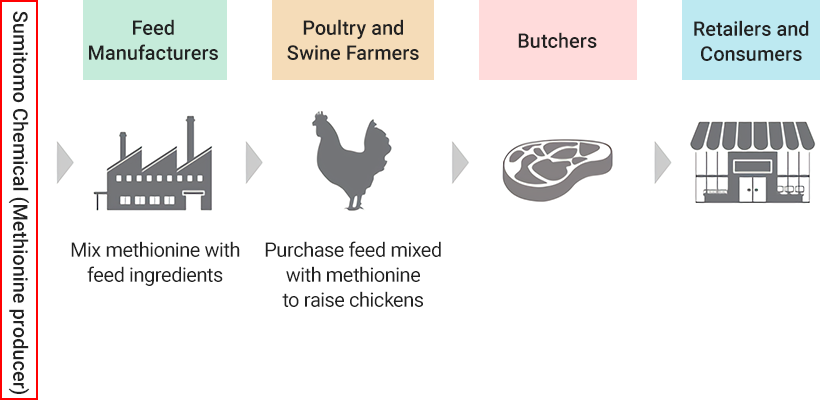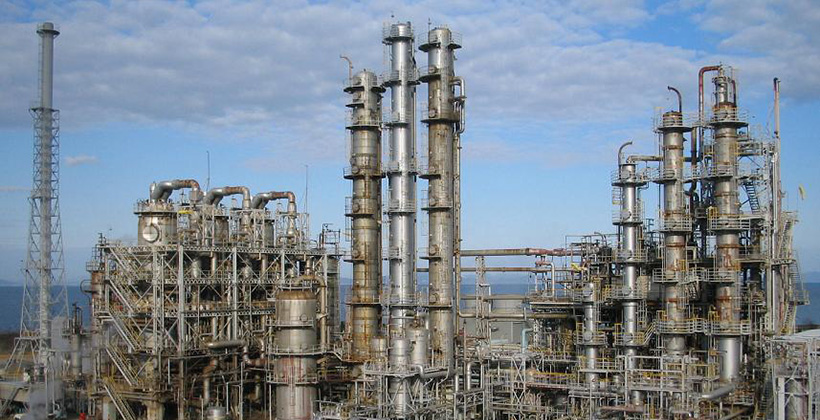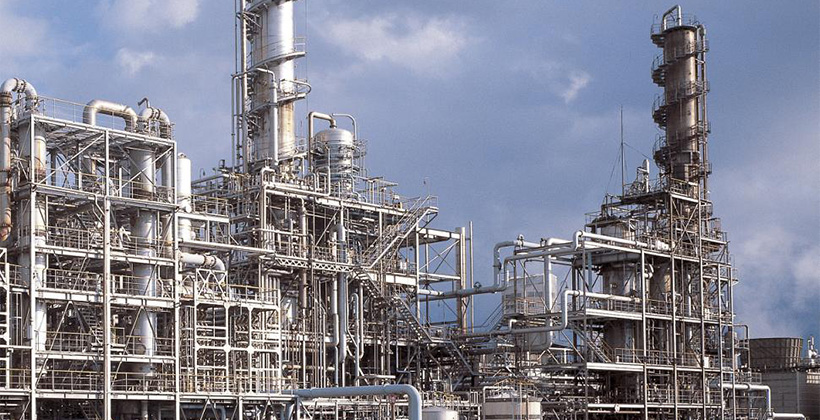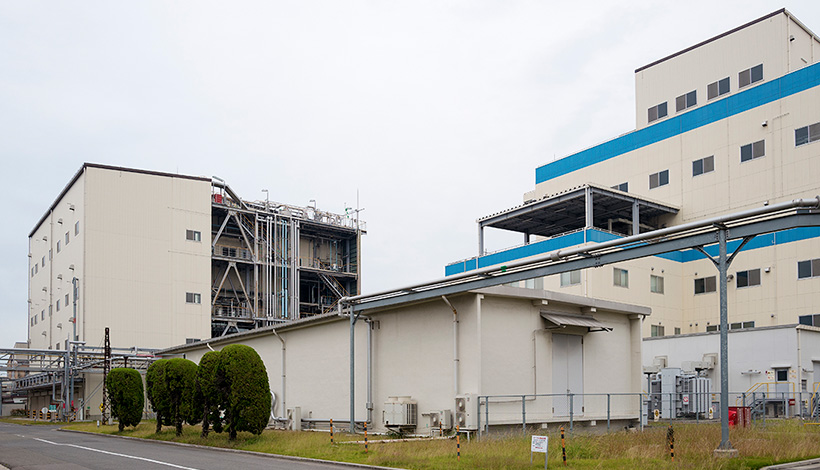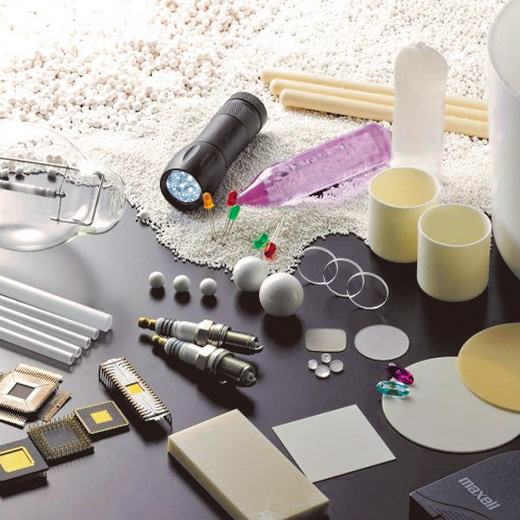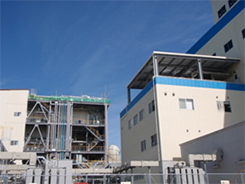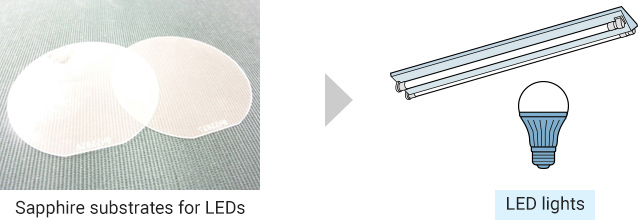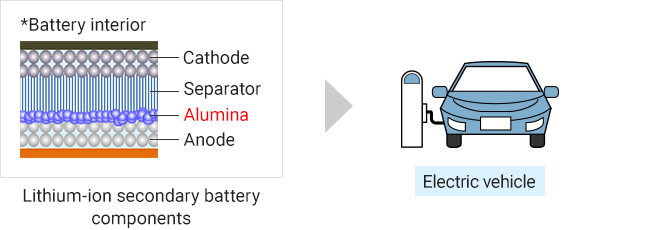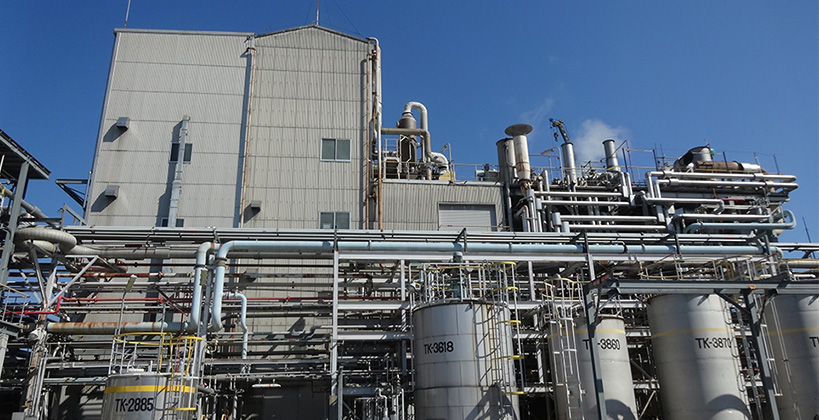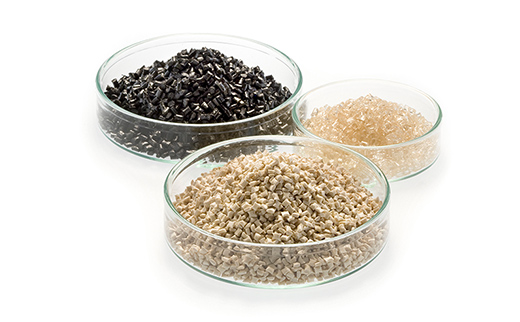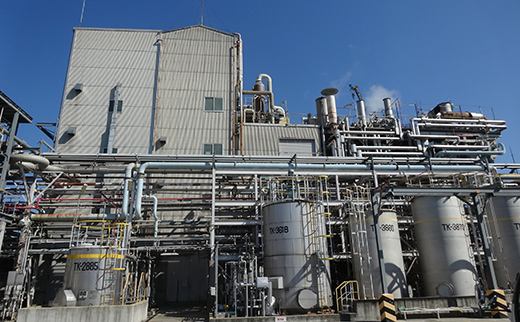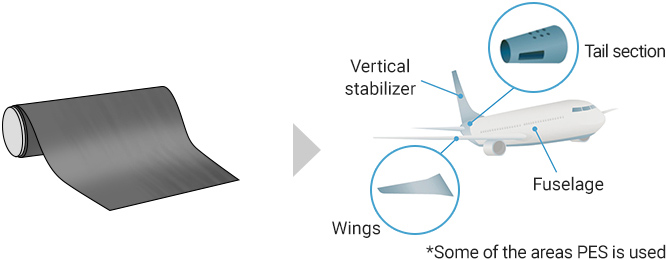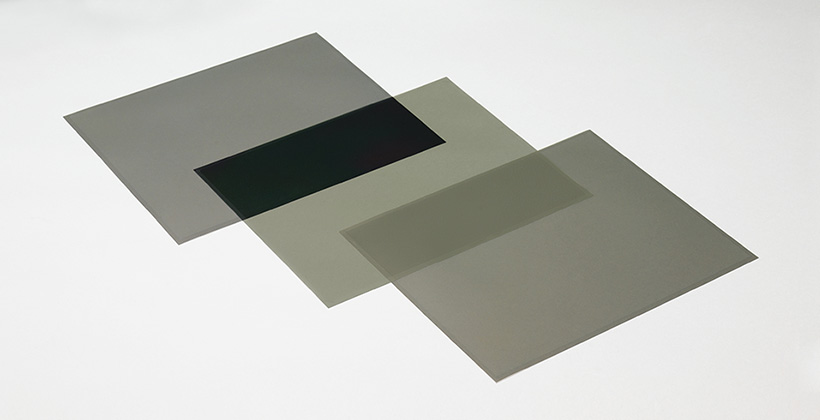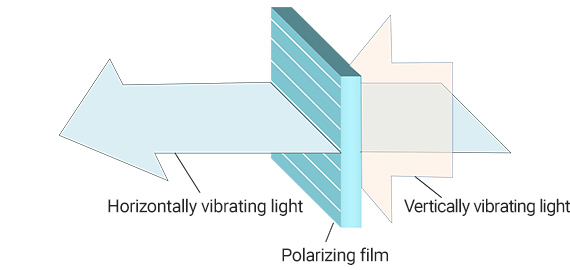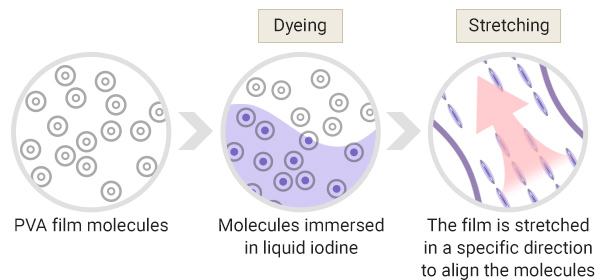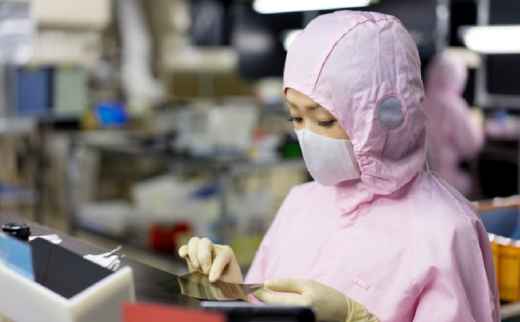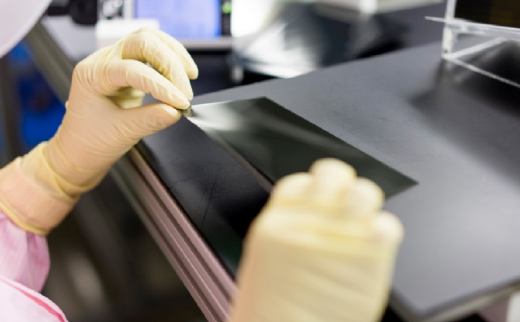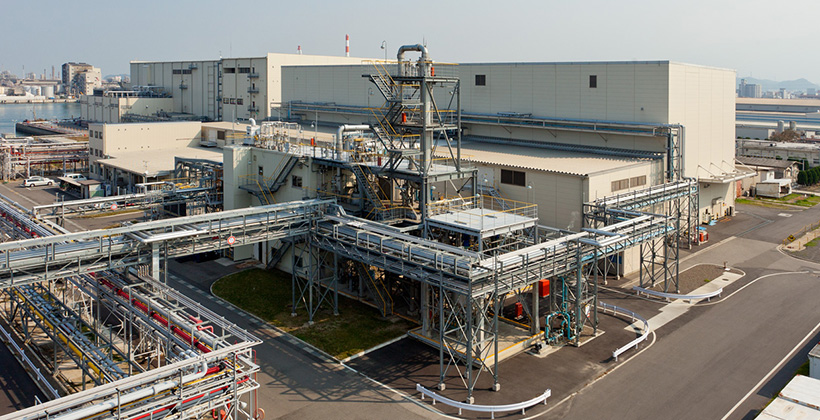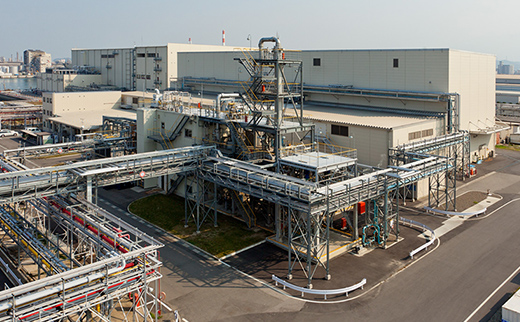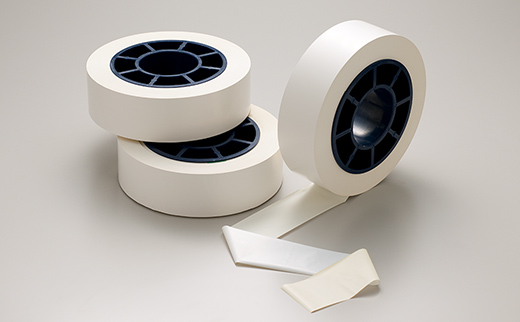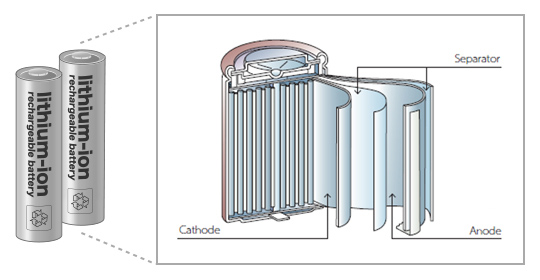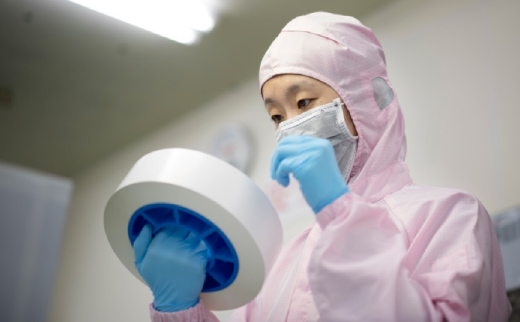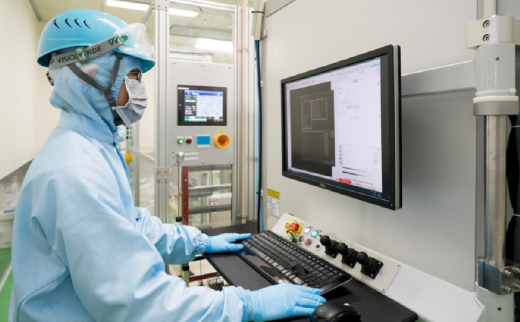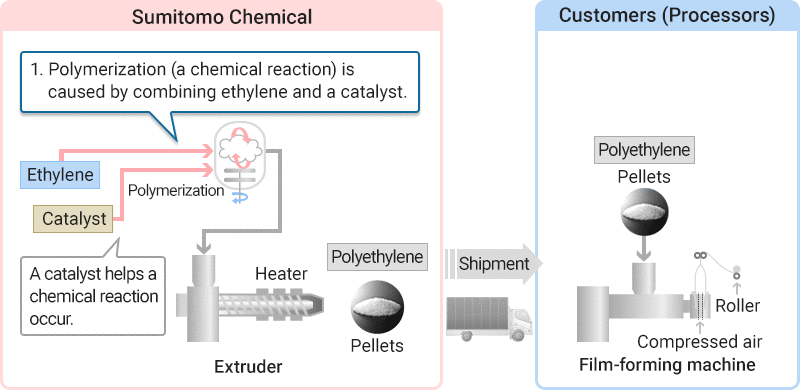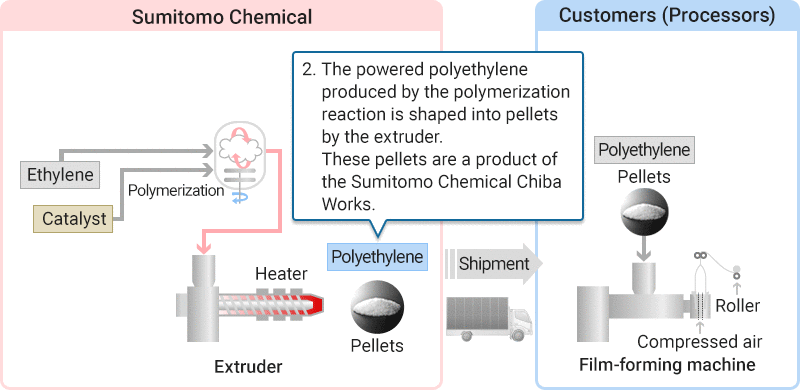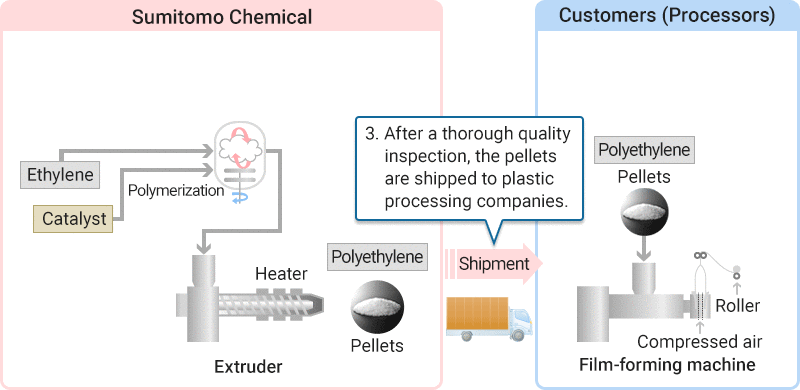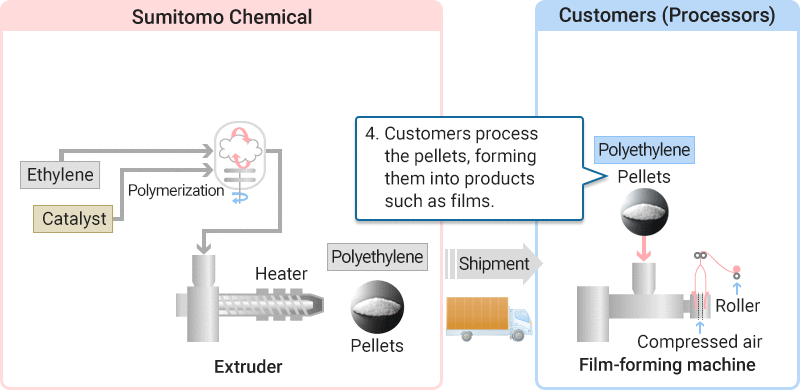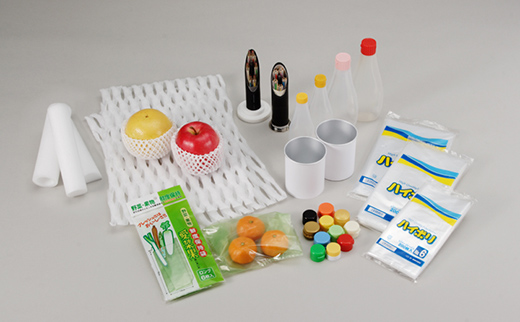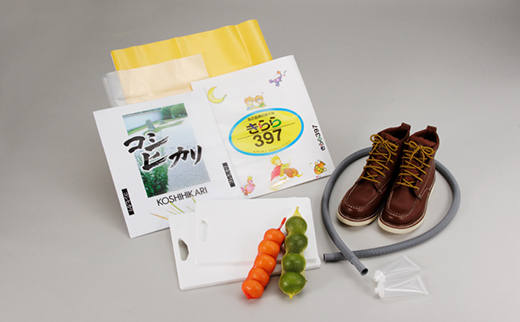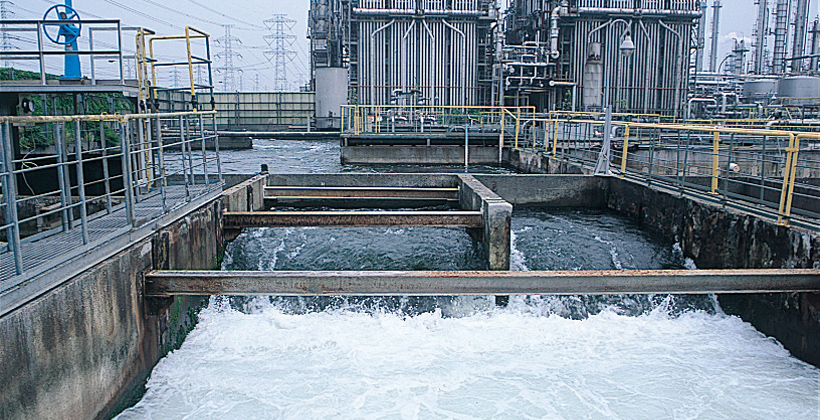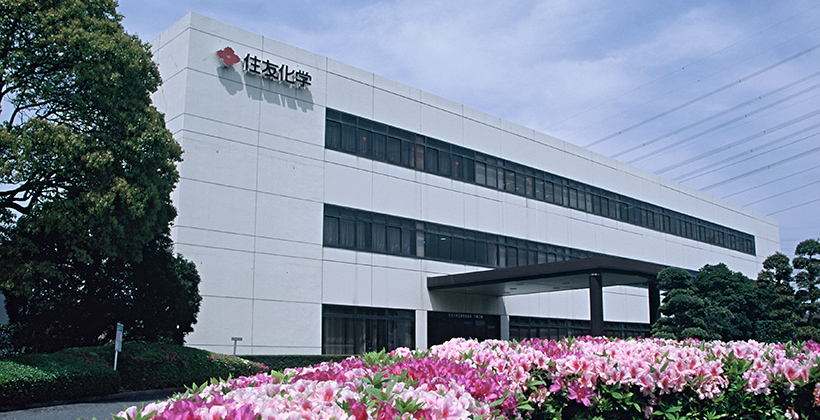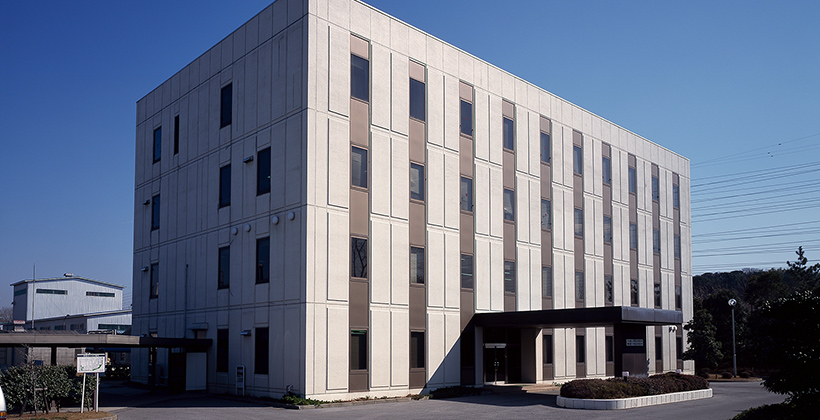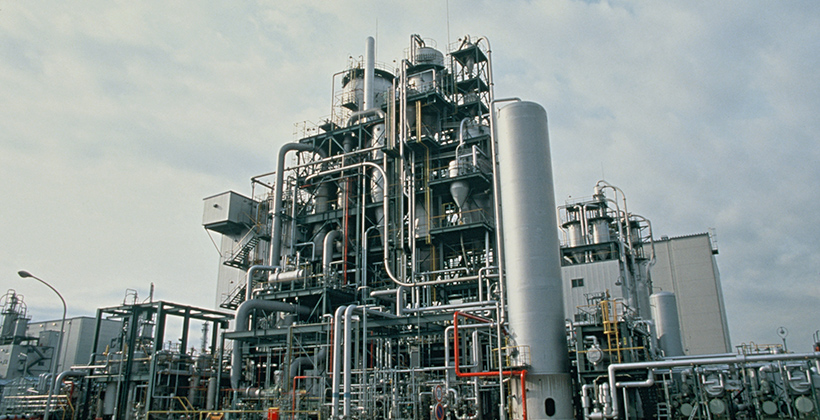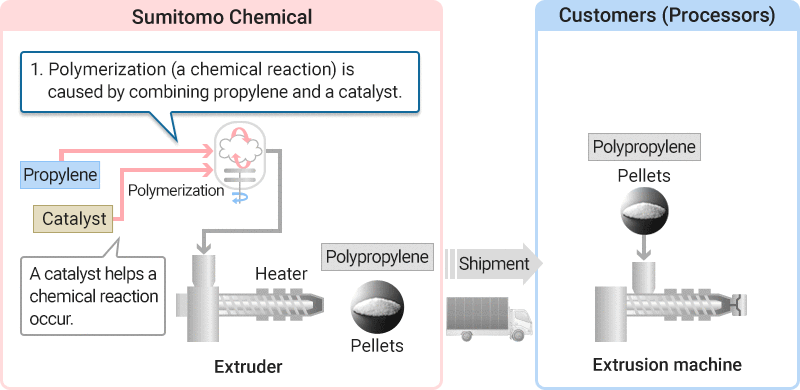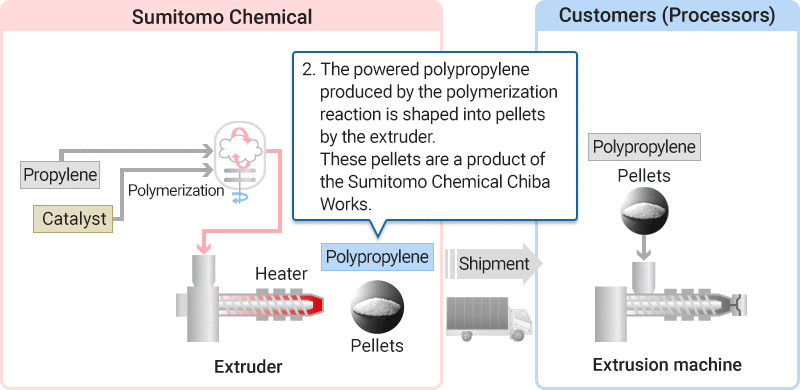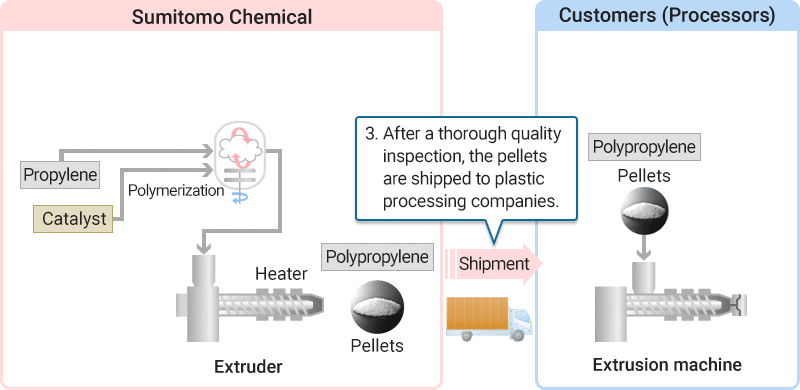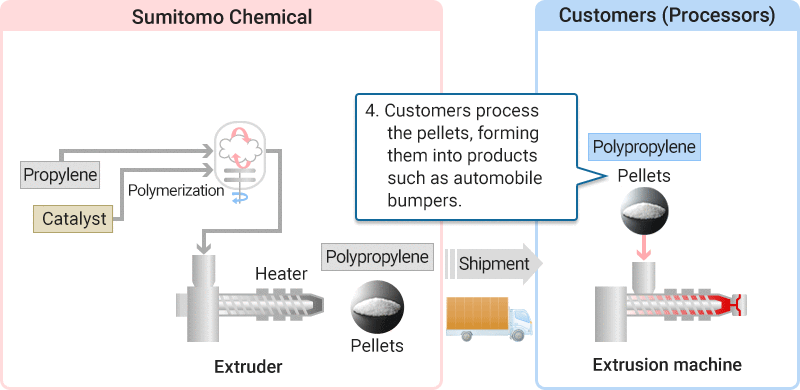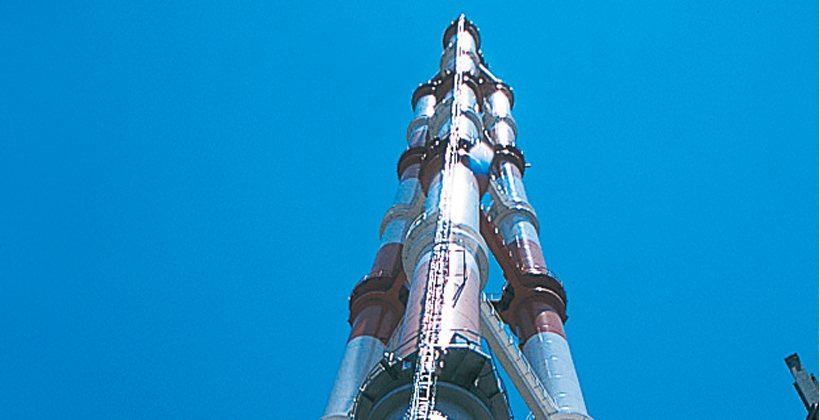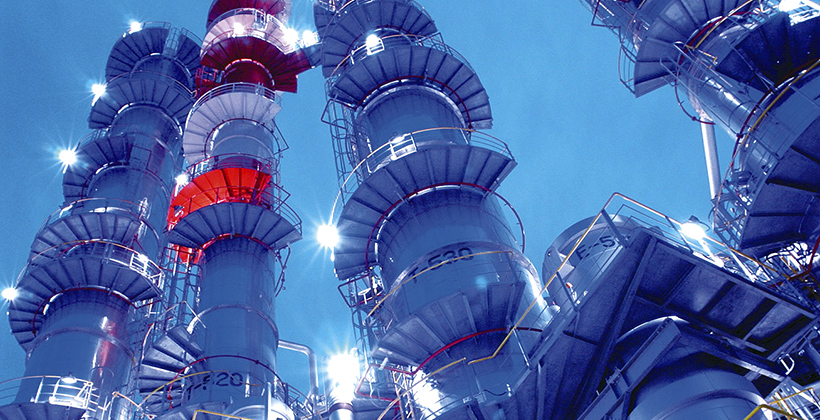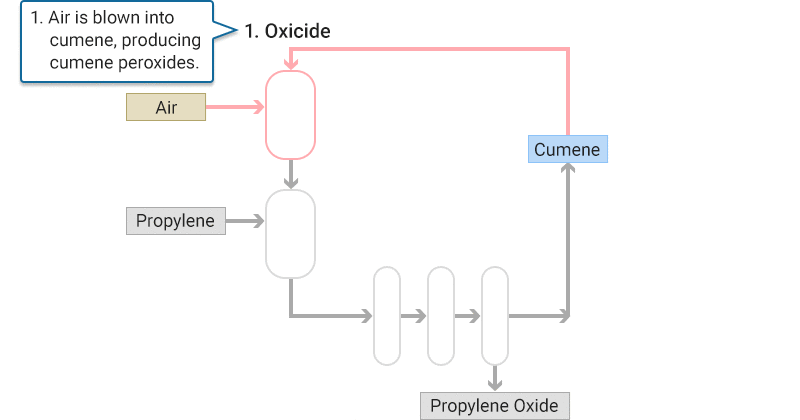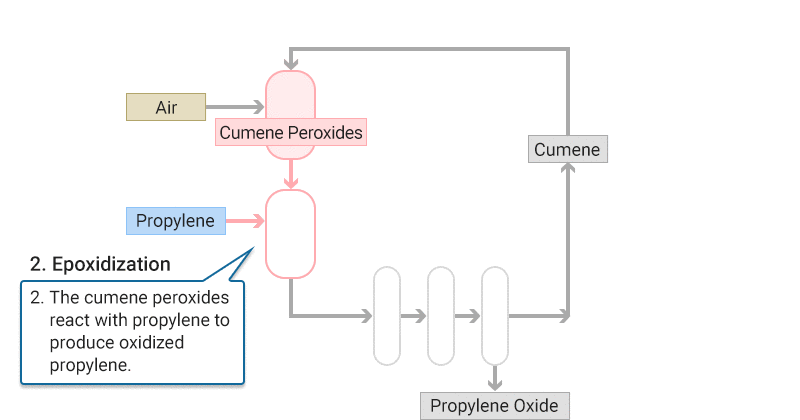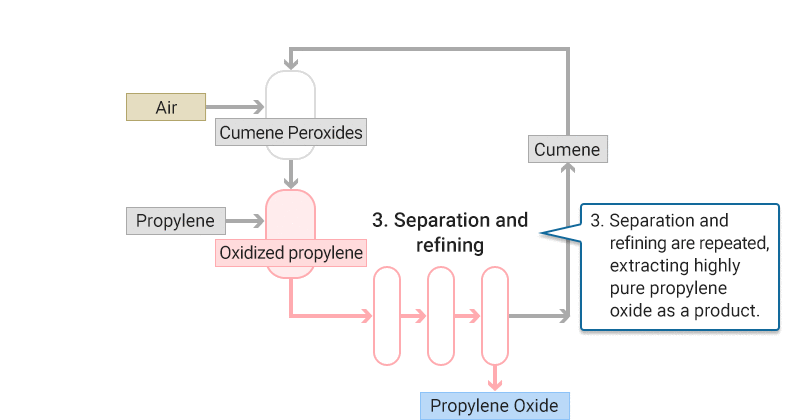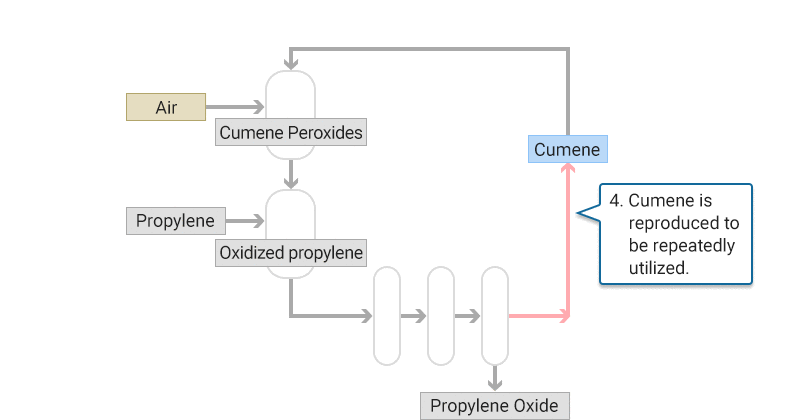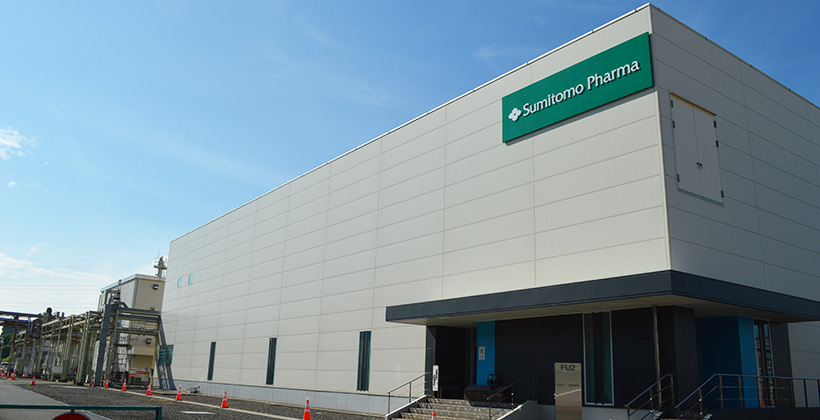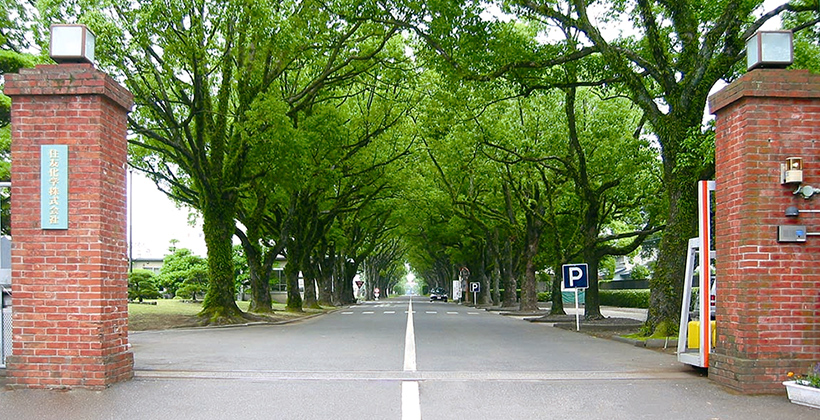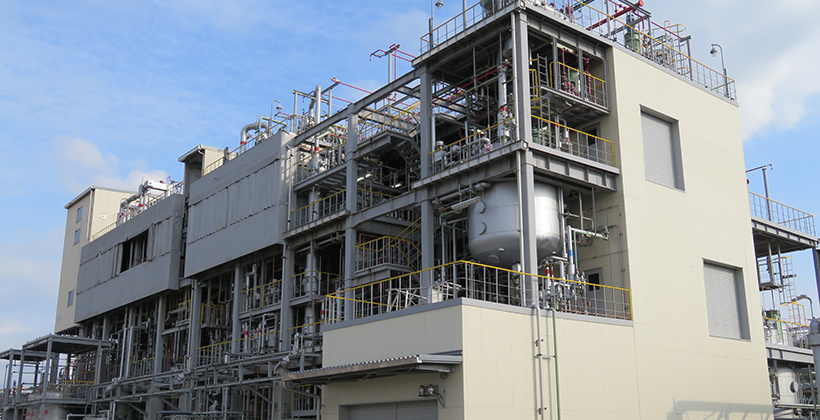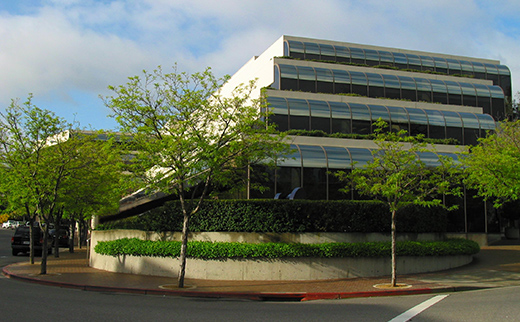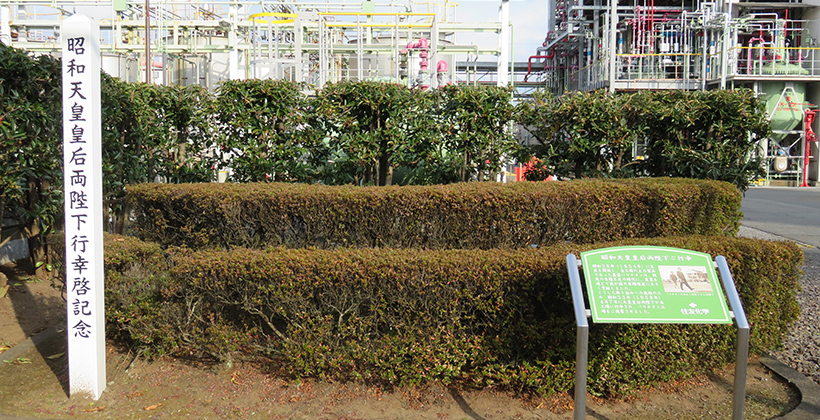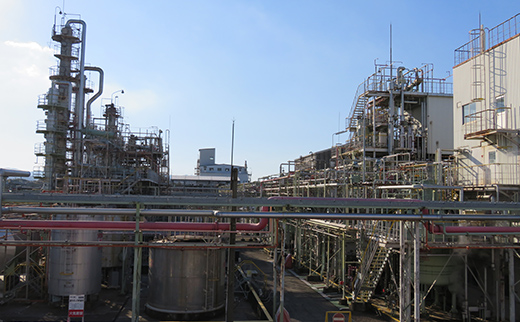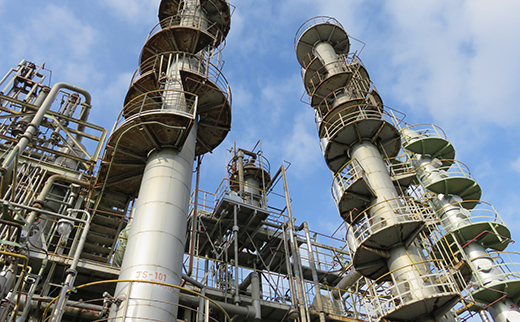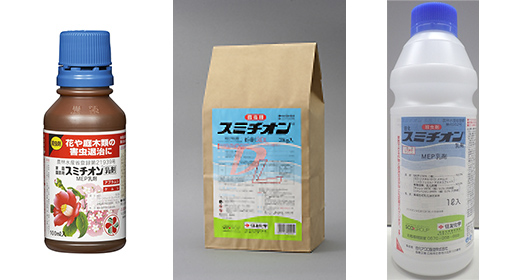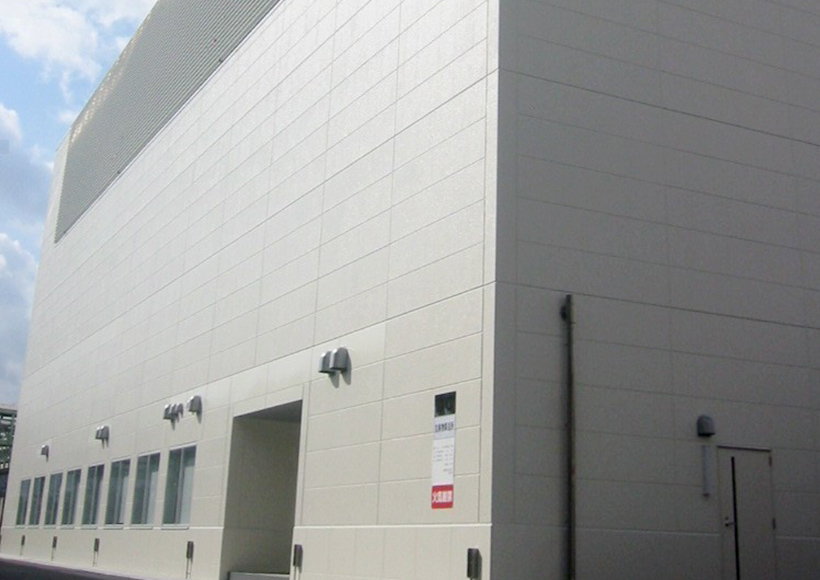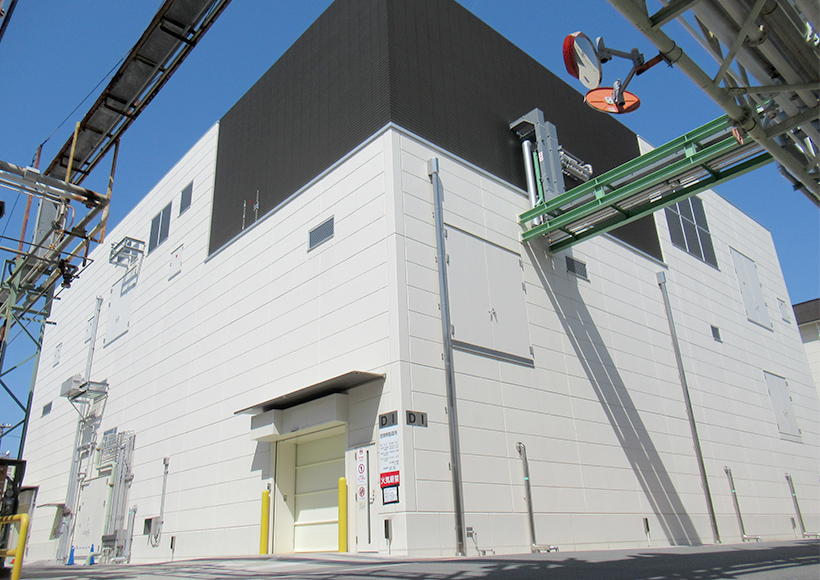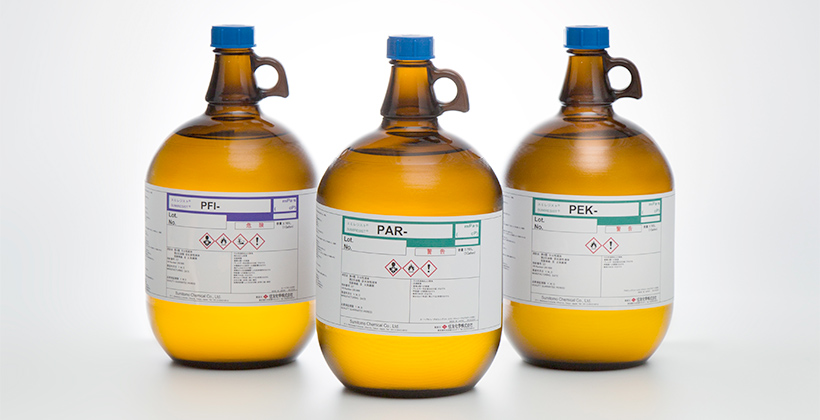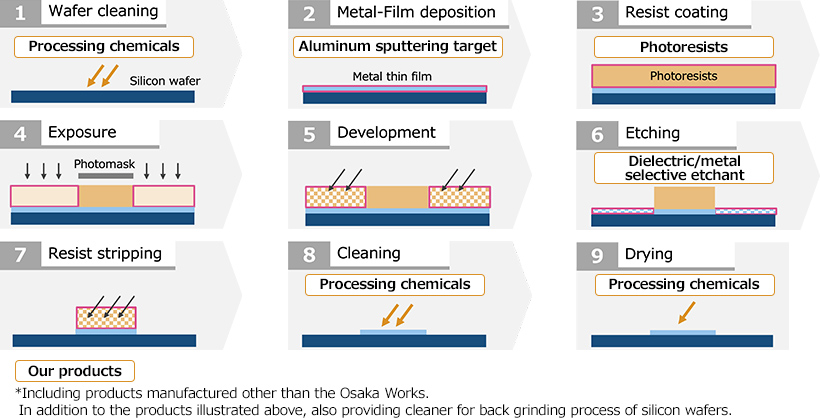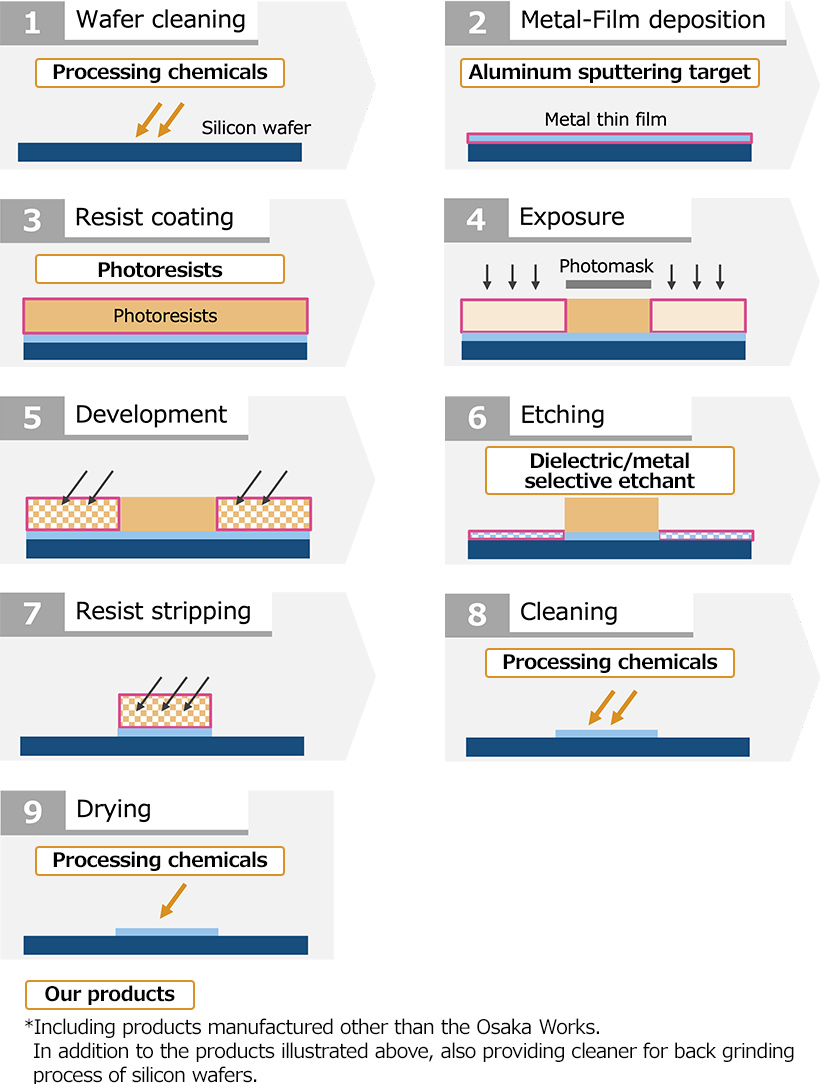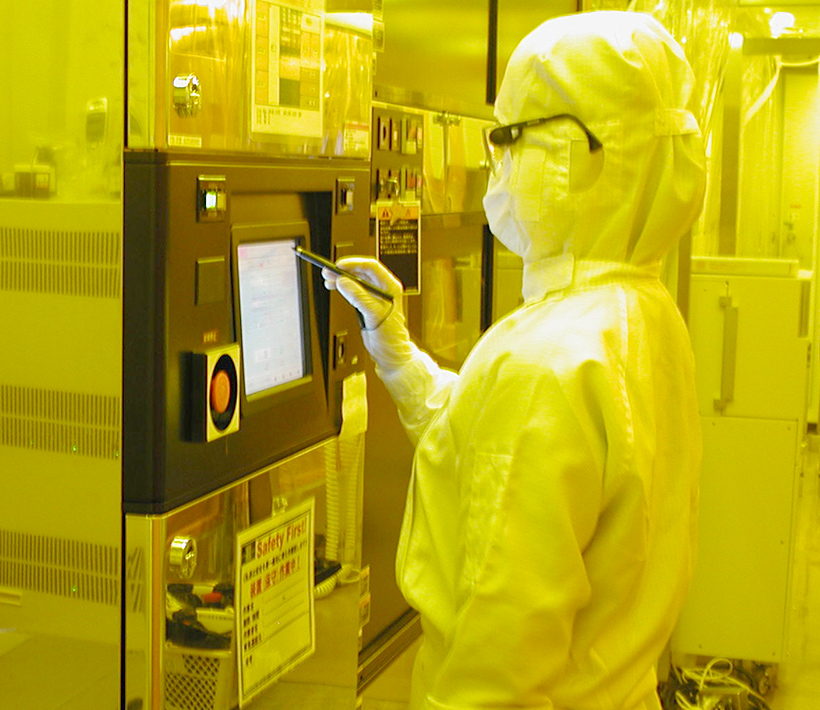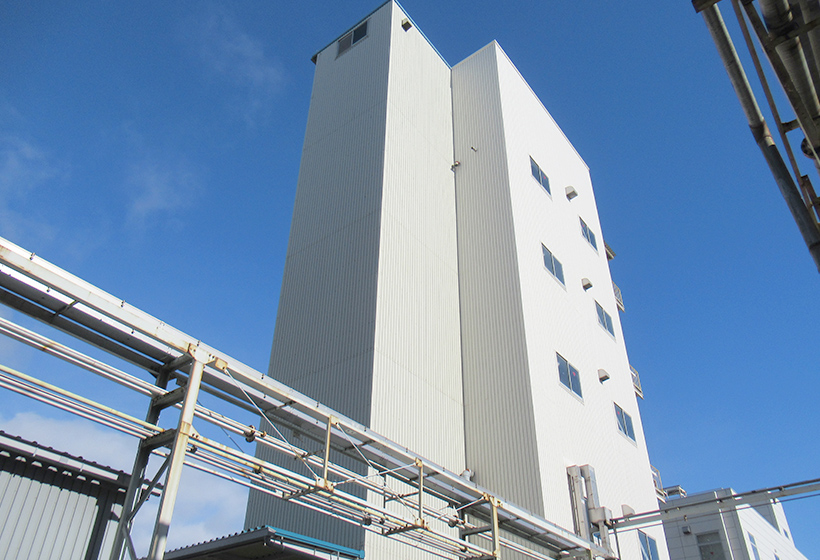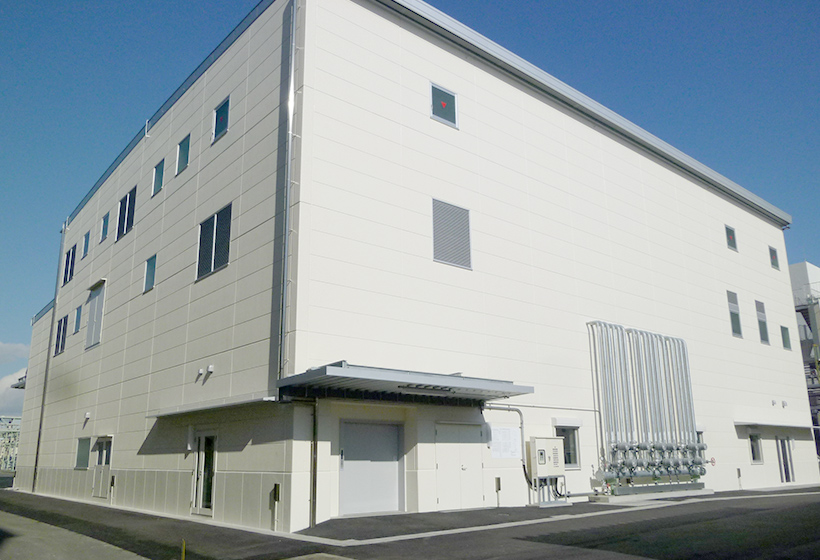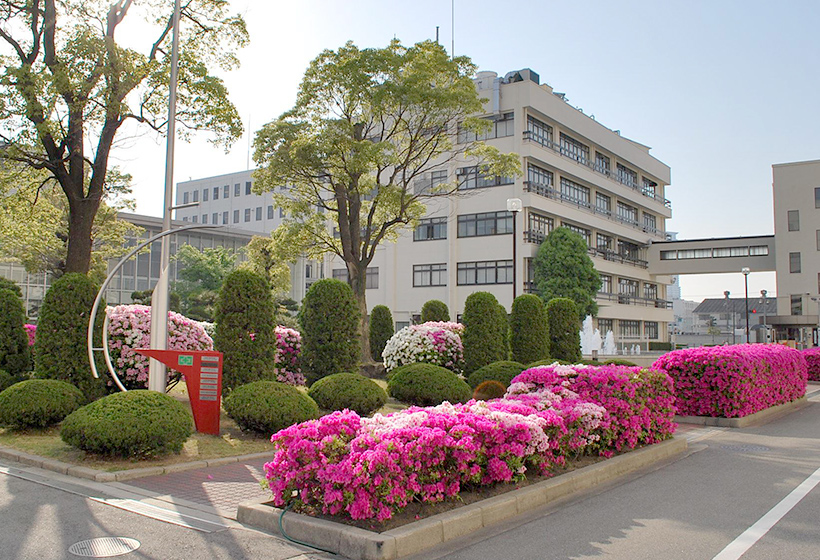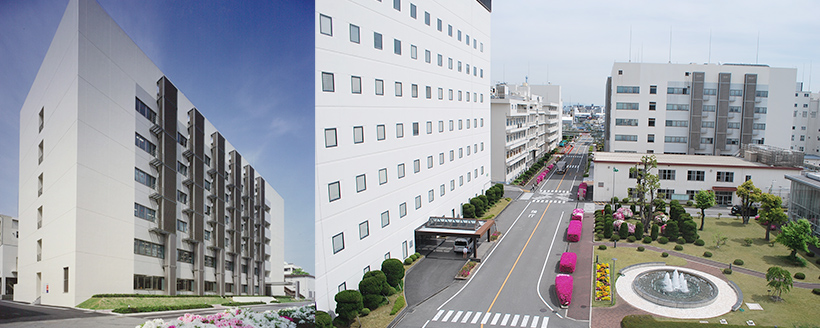Ehime Works and Ohe Works
Welcome to Ehime Works and Ohe Works!
Push the buttons below to find out more details about each plant.
Ehime Works
The Ehime Works are Sumitomo Chemical’s main production facility, consisting of two districts, the Niihama District and the Kikumoto District, with a total area of 3.18 million m2. Sumitomo’s business in Niihama began with the development of the Besshi copper mine. Sumitomo Chemical got its start making fertilizer from the byproducts of the Besshi copper mine.
Ohe Works
The Ohe Works are a production facility for products such as IT-related materials, producing products such as polarizing films for applications such as large TVs and smartphones, and separators for lithium-ion batteries for use in automobiles and other products.
Summary of Each District (Ehime and Ohe Works)
The Ehime Works consist of the Niihama District and the Kikumoto District. The Niihama District is a unique facility, producing a wide variety of types of products for a chemical plant in the same area, including ammonia-based bulk products (including acrylonitrile, caprolactam, aniline, and methionine), fertilizers, MMA monomers (a bulk petrochemical product), and core raw materials such as sulfuric acid and nitric acid, which have been produced here since the business began. In addition to bulk products, the facility also produces fine chemical products, including raw materials for advanced polymers and raw materials for pharmaceuticals and crop protection and enhancement products , as well as polymer product, such as methacrylate resins. Offices and a number of laboratories are also located in this district, making it the core district of the Ehime Works.
The Niihama District encompasses about 1.95 million m2, which could fit the Koshien Stadium 51 times over (or the Tokyo Dome 42 times).
The Kikumoto District began as an aluminum refinery in 1936. Currently, the facility does not refine aluminum, but it does primarily produce aluminum and alumina-related products, as well as chlorine-based products that developed alongside aluminum. The Kikumoto District encompasses about 1.23 million m2, which could fit the Koshien Stadium 32 times over (or the Tokyo Dome 26 times).
The Ohe Works are the birthplace of the petrochemical industry in Japan, achieving many firsts, such as being the first to produce ethylene in Japan in 1958. The facilities encompass about 460,000 m2, which could fit the Koshien Stadium 12 times over (or the Tokyo Dome 10 times).
Ehime Works (Niihama District)
Methionine Plant
This facility produces methionine, which is an essential amino acid used mainly as a feed additive in poultry and swine farming.
Methionine
The Ehime Works produces DL-methionine and Methionine hydroxy analog, which are kind of methionine as an essential amino acid that cannot synthesize within animal bodies.
Application and Effect of Methionine
Because livestock feeds, especially poultry feed, mainly contains cereals such as corn are often deficient in methionine, it has been widely used a methionine as a feed additive for the purpose of improving productivity of meat and egg. In addition, it is possible to promote the efficient use of amino acids within an animal’s body by adding methionine to adjust the balance of amino acids in the feed, which also will cause the reducing nitrogen compound in its waste, which is a cause of greenhouse gas emissions.
Features of the Manufacturing Process: An Integrated Manufacturing Process from Basic Raw Materials
Sumitomo Chemical’s methionine manufacturing process is an integrated process starting from basic raw materials, which enables both high cost competitiveness and stable production.
Methionine’s Path to Final Consumption
The methionine produced in this plant is supplied to feed manufacturers, and then passes through poultry and swine farmers, food processing companies, and then retail establishments to end up on everyone’s table in the form of meat and eggs.
Acrylonitrile Plant
This facility produces a raw material for acrylic fibers, which are used in things like blankets, sweaters, and carpets.
Nitric Acid Plant
Nitric acid is an essential basic raw material, used as a catalyst or an auxiliary material in a variety of chemical reactions.
Niihama LNG (Video)
This facility was built to receive liquefied natural gas (LNG) supplied to the Ehime Works and neighboring industrial customer.
At the Ehime Works, we are working on significantly reducing CO2 emission levels by converting the fuel for power generation from GHG-intensive coal to less GHG-intensive LNG. In April 2018, Niihama LNG Co., Ltd. was established on the premises of the Ehime Works as a joint venture of five companies*.
Niihama LNG is equipped with a 230 thousand m3 LNG tank and a berth where tankers of up to around 180 thousand m3 capacity can be docked. In the terminal, LNG is regasified to ambient temperature gas and then supplied to a thermal power plant (due to be constructed by Sumitomo Joint Electric Power on its premises), to the Ehime Works for fuel use, and to neighboring industrial customer. Currently, the LNG terminal is under construction, with operations are expected to begin in February 2022.
* Jointly funded and operated by Sumitomo Chemical Co., Ltd., Tokyo Gas Engineering Solutions Corporation, YONDEN Shikoku Electric Power CO., Inc., SHIKOKU-Gas Co., Ltd., and Sumitomo Joint Electric Power Co., Ltd.
Sumitomo Chemical History Museum (Video)
This facility exhibits valuable materials from the time of Sumitomo Chemical's foundation to the present.
- Reservations are required for the tour.
Contact Sumika Real Estate Co., Ltd.
TEL +81-897-37-1815
Ehime Works (Kikumoto District)
High-Purity Alumina Plant
Sumitomo Chemical’s high purity alumina refers to alumina that, in addition to offering outstanding physical and chemical characteristics, such as thermal resistance, insulation, abrasion resistance, and corrosion resistance, is over 99.99% pure, which is produced at the Ehime Works and at a plant in South Korea.
What is High-Purity Alumina?
Sumitomo Chemical’s high-purity alumina is not only a kind of alumina that offers outstanding physical and chemical characteristics such as heat resistance, insulation, abrasion resistance, and corrosion resistance, but also holds a purity of over 99.99%, and produced at the Ehime Works and at a plant in South Korea.
Features of the Manufacturing Process: Sumitomo Chemical Uses the Alkoxide Method
While there are a variety of production methods for high-purity alumina, Sumitomo Chemical produces high-purity alumina with a purity over 99.99%, with the manufacturing process most suited for mass production, called the alkoxide method, which uses aluminum and alcohol as its raw materials.
Applications
Demand for Sumitomo Chemical’s high-purity alumina is growing for a variety of new applications, including sapphire substrates, lithium-ion secondary batteries, and thermal pads used as battery materials.
Sapphire Substrates
Sapphire substrates are used for applications such as watch faces, fingerprint sensors and camera lens covers for smartphones, and substrates for gallium nitride membranes, essential for LED chips. High liquidity alumina with few impurities is preferred.
Lithium-Ion Secondary Batteries
Alumina is used as a safety measure to improve the heat resistance of separators and prevent shorts within batteries. Alumina with few impurities, low gas emissions, and the capability to function as a membrane with high ion permeability is preferred.
Thermal Pad
This is a component that fills in the gaps and irregularities in between a heat-producing device and a substrate, or between a substrate and a heatsink, taking on the role of efficiently transferring heat to the substrate or heatsink. Alumina with uniform granule size is preferred.
High Performance Engineering Plastics Plant
This plant produces High Performance Engineering Plastics, which offer not only the highest level of thermal resistance among thermoplastic resin, but also outstanding mechanical strength and chemical resistance.
What Are High Performance Engineering Plastics?
Plastics that offer performance that exceeds that of general use plastics, such as in heat resistance and mechanical strength, and which offer the high reliability that makes them suitable for use as industrial components, are called “engineering plastics.”
This plant produces plastics (liquid crystal polymers (LCPs) and polyethersulfone (PES)) that have performance exceeding even that of engineering plastics (particularly in thermal resistance and mechanical strength at high temperatures), called “super engineering plastics.”
Features of the LCP Manufacturing Process: Use of a Catalyst Method
Among LCPs, Sumitomo Chemical’s LCPs offer the highest level of thermal resistance, flame resistance, and fluidity.
In addition, they are environmentally-conscious materials that offer outstanding flame resistance without containing halogens.
Sumitomo Chemical began sales in 1972, making an early entry into the global market in the LCP industry.
Sumitomo Chemical uses a catalyst method in its manufacturing process, which provides high productivity and LCP of outstanding quality.
Features of the PES Production Process: A Dedicated PES Production Plant
PES is a high-functionality polymers with high dimensional accuracy and thermal resistance, even for a High Performance Engineering Plastics.
It has received attention in recent years as a material that can substitute for metal, particularly in automobile components.
In addition, Sumitomo Chemical’s high-functionality PES has a unique property that can produce very high strength when used as a carbon fiber composite material in aircraft.
Sumitomo Chemical’s PES, used in this sort of application that requires high reliability, is produced in a plant that is specialized for only PES production, offering a high quality product that is not mixed with other products.
Applications
Details of the applications of LCPs and PES are shown below.
Liquid Crystal Polymers (LCPs)
LCPs offer outstanding thermal resistance, fluidity, and dimensional stability, and are mainly used in electronic components such as connectors.
Connector Applications
LCPs are used in connectors (components used to connect lines in electrical circuits or optical communications) for devices such as PCs and mobile phones.
Optical Pickup Bobbin Applications
LCPs are used in products such as the read heads for optical discs.
Polyethersulfone (PES)
PES offers outstanding flame resistance, thermal resistance, and dimensional stability. It is used as a carbon fiber composite material for aircraft, and it is also seeing growth in use in automotive and membrane applications.
Aerospace Applications
PES is used in carbon fiber composite material applications for aircraft fuselages. It contributes significantly to the lightening of the aircraft and to the accompanying improvement in fuel consumption performance.
Automotive Applications
In the automotive industry, seen in a key phrase of reducing weight, there is a trend toward improving the fuel consumption and performance of next generation vehicles, including hybrids, electric vehicles, and fuel cell vehicles, and so there has been a rapid increase in inquiries about super engineering plastics, which are lighter than metal.
Membrane Applications
Due to its outstanding workability, thermal resistance, and biocompatibility, use of PES is also expanding into separation membrane applications for water purification, food-related uses, and medical uses.
Ohe Works
Polarizing Film Plant
Polarizing films are films that control the orientation of the light that passes through them. This facility produces polarizing films for both large TVs and for smartphones and tablet devices.
Polarizing Film
This plant produces polarizing films, which are specialized films used in TVs and smartphone displays that allow only light waves vibrating in specific directions to pass through, and block light from other directions.
The Structure of Polarizing Film
Light from the sun, and from electric lights, has the properties of a wave of light, vibrating in all orientations in its direction of travel.
Polarizing film acts as a sort of shutter for light, through which only light waves vibrating in specific orientations can pass, while other light waves are blocked.
Light waves with a specific orientation are called polarized light. These films are used in displays to make use of this capability.
The Manufacturing Process for Polarizing Film
As shown below, this manufacturing process is known for its continuous production of rolls of film. It is also a process with high productivity, operating at high speeds. Sumitomo Chemical’s polarizing film is extremely thin, requiring advanced technology to produce.
Substrate Feed
In the substrate feed step, rolls of polyvinyl alcohol (PVA) film are continuously spooled out into the production process.
Dyeing and Stretching
The PVA film is immersed in liquid iodine, dyeing the PVA molecules.
By stretching this dyed film in a specific direction with great force, the PVA molecules line up, producing a polarizing effect.
Drying
The film is dried with heat and air.
Bonding with Protection Film
In this step, the polarizing film, which is easy to tear, is laminated with other films, including a protection film to protect it physically, and optical compensation film to add functionality.
Take-up
The polarizing film, now laminated with the protection film and other films, is taken up on a roller. After being rolled, it is put through other processes as necessary, and then die-cut according to the size of the final product.
Production in an Impeccable Environment and System
At Sumitomo Chemical’s facilities, production is done in an impeccable system for eliminating contaminants such as microscopic dust, using a cleanroom and covering the areas the film passes through in clean booths.
In addition, by detecting imperfections such as contaminants, cavities, or tears, with an impeccable inspection system, Sumitomo Chemical is able to produce a high quality product with a high yield.
Separators for Lithium-Ion Secondary Batteries Plant
This plant produces a film, called a separator that separates the cathode and the anode of lithium-ion secondary batteries, separators have gained attention recently for their use in products such as electric vehicles.
Separators for Lithium-Ion Secondary Batteries
This plant produces a film called a separator, which separates the cathode and the anode of lithium-ion secondary batteries.
By combining a polyolefin substrate with a heat resistant layer made of aramid resin, which has a high heatproof temperature, Sumitomo Chemical’s separators achieve a significant heat resistance, contributing to the improvement of safety for lithium-ion batteries.
The Interior of a Lithium-Ion Secondary Battery
Separators are placed between the cathode and the anode, playing the primary role of preserving insulation between them. As contact between the cathode and anode (a short) may cause a fire, separators are an indispensable component of lithium-ion secondary batteries to ensure their safety.
The Separators Manufacturing Process
The production process involves technologies such as film processing technology, aramid resin synthesis technology, thin film coating technology, and in-line defect inspection technology, producing separators using technology that combines various elements of hybrid chemistry, Sumitomo Chemical’s slogan.
- Base Film Production Process: A process that produces the base film (a microporous membrane) from polyolefin raw materials.
- Aramid Process: A process that synthesizes aramid polymers and produces the aramid coating liquid that forms the heat resistant layer.
- Coating Process: A process that coats the base film evenly with the aramid coating liquid, forming the heat resistant layer.
- Slitting Process: The film is cut to the size of customers’ needs.
Quality Control and Inspection System
A visual inspection of all products is conducted before shipment.
Advanced quality control is thoroughly conducted using a variety of analysis devices.
The Path from Separators to Final Products
Separators produced by Sumitomo Chemical are supplied to battery manufacturers. The batteries are used in products such as automobiles and power tools.
Chiba Works
Wecome to Chiba Works!
Push the buttons below to find out more details about each plant.
Chiba Works
The Chiba Works is a manufacturing location for Sumitomo Chemical’s Essential Chemicals & Plastics Sector, divided into three districts – the Anesaki District, Sodegaura District I, and Sodegaura District II – with a total area of 2.17 million m2. In coordination with the Essential Chemicals Research Laboratory, which is located in the same area, these facilities support the global business development of the Essential Chemicals & Plastics Sector in locations such as Saudi Arabia and Singapore.
Summary of Each District (Chiba Works)
Production of products such as polyethylene, polypropylene, and propylene oxide is conducted in Sodegaura District II. Production of resorcinol and synthetic rubber products such as ethylene-propylene rubber is conducted in Sodegaura District I. Production of products such as polyethylene and acetaldehyde is conducted in the Anesaki District.
The Petrochemical Product Production Process
This diagram shows the process by which crude oil is turned into major petrochemical products of the Chiba Works.
- On this site, the actual manufacturing process is presented in a simplified, graphical form.
Anesaki District
Polyethylene Plant
The Polyethylene Production Process
Polyethylene is a synthetic resin that is flexible, highly resistant to water and chemicals, and can be easily processed.
Sumitomo Chemical manufactures polyethylene with a vapor phase method developed in-house. This vapor phase method is also used at the plants of Sumitomo Chemical Group companies outside Japan.
Wastewater Treatment Facility
For the wide variety of types of wastewater produced alongside chemical reactions, Sumitomo Chemical processes them based on their various characteristics. More specifically, wastewater is emitted after being purified by a comprehensive wastewater treatment system, including submerged combustion processing and activated sludge processing for wastewater containing organic compounds, cohesion precipitation processing and sand filtration processing for wastewater containing suspended solids, and parallel plate oil water separation processing for wastewater containing oils.
Anesaki Office
Sodegaura District I
Essential Chemicals Research Laboratory
As the research and development facility for the Essential Chemicals & Plastics Sector, with research efficiency and speed, the Essential Chemicals Research Laboratory pursues the development of polymers. It also develops and improves catalysts and manufacturing processes.
Sodegaura District II
Polyethylene Plant
The Polyethylene Production Process
Polyethylene is a synthetic resin that is flexible, highly resistant to water and chemicals, and can be easily processed.
Sumitomo Chemical manufactures polyethylene with a vapor phase method developed in-house. This vapor phase method is also used at the plants of Sumitomo Chemical Group companies outside Japan.
Polypropylene Plant
This plant manufactures polypropylene with a method that uses catalysts and a process developed in-house, called the vapor phase method.
The Polypropylene Productios Process
Polypropylene is a synthetic resin that provides multiple advantages: it is light and can be easily processed, is highly durable, and highly resistant to heat and chemicals.
Sumitomo Chemical manufactures polypropylene with a vapor phase method developed in-house. This vapor phase method is also used at the plants of Sumitomo Chemical Group companies outside Japan.
Applications
Polypropylene is widely used as a material for automobile bumpers, instrument panels, food trays, home electrical appliances, and medical instruments.
-

Automobile instrument panel
-
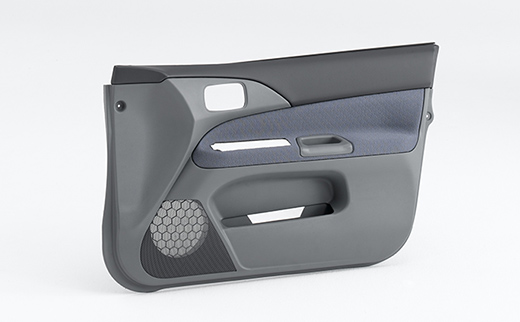
Door trim of automobile
Air Pollution Prevention Equipment
The Chiba Works has multiple boilers for producing electricity in-house and multiple furnaces for use in chemical processes, and when fuel is burned in this sort of equipment, smoke is produced (which includes components such as sulfur oxides, nitrogen oxides, and soot). In order to control the emission of smoke into the atmosphere, Sumitomo Chemical uses high-quality fuels, and has set up smoke desulfurization equipment, smoke denitrification equipment, and electric dust collectors.
Propylene Oxide Plant
This plant manufactures propylene oxide using the world’s first manufacturing process that does not produce byproducts.
The Propylene Oxide Production Process
Propylene oxide is a derivative of propylene.
Sumitomo Chemical manufactures propylene oxide using a method called the propylene oxide-only process.
This process produces only propylene oxide, without producing any byproducts or coproducts, through the cyclic usage of cumene. In addition, this process offers high cost competitiveness, as it not only saves on resources and energy, making effective use of the heat produced by the reaction and limiting wastewater, the equipment used in the process is also more compact that that of previous manufacturing processes.
Applications
Propylene oxide is mainly used to manufacture propylene glycol and polyurethane
Propylene glycol is used in a number of products, such as pharmaceuticals and cosmetics.
Polyurethane comes in both soft and hard forms. Utilizing its excellent cushioning properties, the soft form is used in products such as automobile and train seats, as well as sofas. The hard form, on the other hand, has outstanding thermal insulation properties, so it is used as a thermal insulator for buildings and refrigerators, among others.
-

Automobile seats using polyurethane cushioning material
Oita Works
Welcome to Oita Works!
Push the buttons below to find out more details about each plant.
Oita Works
The Oita Works began as an intermediates production base for dyes established in 1939 by the Japan Dyestuff Manufacturing Company, which was Japan’s leading dye manufacturer.
After merging with Sumitomo Chemical, it now manufactures products such as crop protection and enhancement products, pharmaceuticals, and other chemical products, serving as the main facility for life science chemicals for the Sumitomo Chemical Group.
The total area of the Oita Works is about 770,000 m2. It is notable for being divided into an orderly grid pattern. There is a central road running about 1 km from east to west in the plant, which is recognized even by the city of Oita as a local landmark, with camphor trees growing along both sides.
Oita Works
Sumitomo Pharma
Oita plant of Sumitomo Pharma, a subsidiary of Sumitomo Chemical, is located on the same grounds, which was taking over from Sumitomo Chemical in 2003. In its state of the art facilities injectable drugs and the active pharmaceutical ingredients are manufactured that support even strict GMP standards (Good Manufacturing Practice).
Camphor Trees
The facility has a number of camphor trees over 50 years old, with about 200 growing along the main east-west road, and over 1,000 growing across the facility as a whole. There are a total of about 20,000 trees and shrubs of about 100 different varieties growing on the grounds, including gingko and sweet viburnum.
Crop Protection and Enhancement Products Plant (Herbicides)
Sumitomo Chemical, a leading manufacturer of crop protection products in Japan, contributes to the improvement of agricultural productivity around the world. The Oita Works plays a pivotal role in manufacturing crop protection products such as insecticides, herbicides, and fungicides for Sumitomo Chemical’s global operations, and these products are exported to over 100 countries.
Herbicide (Flumioxazin)
Flumioxazin, Sumitomo Chemical’s signature herbicide product for crops such as soybeans is used primarily outside Japan. The Oita Works produces the active ingredient of flumioxazin, which controls weeds for long periods of time once applied to soil.
Sumitomo Chemical received the Okochi Memorial Production Prize* for the development of flumioxazin in the 63rd Okochi Memorial Awards (2016).
This award recognized the outstanding contribution to the progress of science and the development of industry of the entire process, from the invention of flumioxazin to the development of the production method.
-
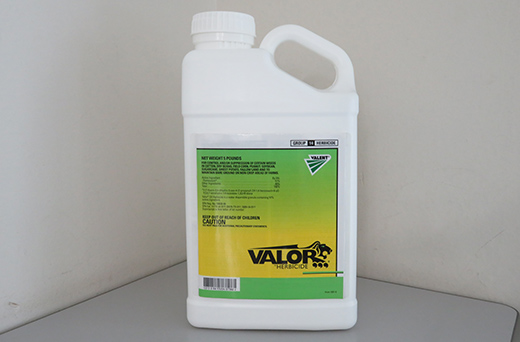
-
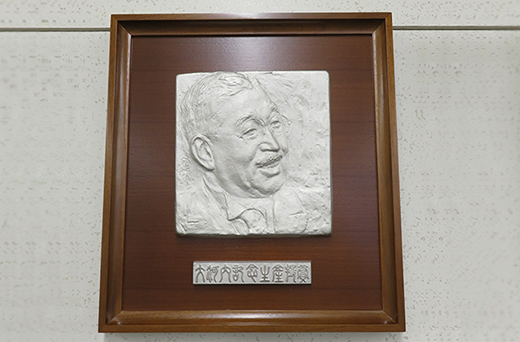
*The relief plaque for the Okochi Memorial Production Prize, received by Health & Crop Sciences Research Laboratory, one of Sumitomo Chemical’s laboratories
*What is the Okochi Memorial Production Prize?
This award, recognizing Japanese achievements relating to the research and implementation of production engineering, production technology, and production systems, is the highest award for business entities among the Okochi Memorial Awards, which recognize individuals, groups, and business entities for remarkable achievements that have significantly contributed to the progress of science and the development of industry.
Unified Production of Flumioxazin, from active ingredient to Formulation
The Oita Works manufactures flumioxazin active ingredient with a competitive process consisting of a synthesis method satisfying both high yield and safety, and continues its stable operation for more than 20 years.
Flumioxazin: as exports
Flumioxazin active ingredient produced in the Oita Works is primarily exported to other countries, making it one of Japan’s largest exported crop protection products in terms of value.
The primary export destinations are North, Central, and South Americas, where Valent U.S.A., a Sumitomo Chemical subsidiary, manufactures formulated products using the active ingredient for local distribution.
Memorial Commemorating the Imperial Visit of Emperor Showa and the Empress
In 1958, Emperor Showa and the Empress toured this facility, in recognition of the significant contributions of the crop protection products produced at this plant to the resolution of the post-war food supply difficulties.
Crop Protection and Enhancement Products Plant (Insecticides)
As Japan’s leading crop protection products manufacturer, Sumitomo Chemical contributes to the improvement of agricultural productivity around the world.The products manufactured at the Oita Works, such as insecticides, herbicides, and fungicides, are exported to over 100 countries, thereby supporting Sumitomo Chemical’s global business.
Insecticide (Sumithion/common name: Fenitrothion)
This plant manufactures Sumithion, an insecticide used in rice paddies, pastures, orchards, forests, and households. Manufactured since 1962, it has become one of the longest-selling insecticides, used around the world.
Even today, 50 years after it was first launched, Sumithion is recognized for its high effectiveness and safety, and it is used around the world against a number of types of insects in a wide range of applications, including for various types of crops, to protect livestock, and for trees and pastures. In short, Sumithion is an insecticide that is not only effective, but is also safe for people and the environment, leading the way in meeting ecological needs.
Unified Production of Sumithion, from active ingredient to Formulation
Oita Works handles everything from production of the active compound in Sumithion to formulation of the final product. By increasing yield and effectiveness through continual improvements, this has become a high performing, highly cost-competitive product.
Sales of Sumithion
Formulations are available at outlets such as agricultural cooperatives, retail stores, and home centers.
Osaka Works and Research Laboratories
Welcome to Osaka Works and Research Laboratories!
Push the buttons below to find out more details about each plant and research laboratory.
Osaka Works and Research Laboratories
Osaka Works is located near the coast of Konohana-ku, Osaka City. The site spans approximately 290,000 m2, and houses both the Business Sector Research Laboratories and the Corporate Research Laboratories. Osaka Works, in cooperation with these research laboratories and group companies, is leveraging the technology it has cultivated over many years to thoroughly meet the diverse needs of its customers.
Osaka Works and Research Laboratories
Photoresists Plant
Photoresists are a light-sensitive resin used to print the high-density circuit pattern on semiconductor wafers and printed circuit boards.
The Advantages of Photoresists
Photoresists are materials mainly used in the micro-fabrication of semiconductor circuit patterns, which are then disposed of after the pattern is formed and do not remain the final product. Photoresists are designed according to exposure wavelengths, such as i-line, KrF, ArF, and EUV (Extreme Ultraviolet), with the latter able to conduct fine processing. Our photoresist development initiative is also tackling a new method of developing the material, which uses material databases and AI to search for new materials (resins, photoreactive agents, and additives) based on mechanisms that lead to improved lithographic performance, and to develop the optimal combination of these materials.
Some of the steps in the semiconductor manufacturing process
Photoresists are used in steps 3 through 7 in the manufacturing process. They are extremely important materials for manufacturing semiconductors.
Manufacturing Photoresists
Photoresists require a stable supply of high quality materials. Due to this, in addition to thorough quality control of the materials used in them, we have a safe system in place to prevent contamination. The products we manufacture undergo chemical analysis and evaluation, and are delivered to our customers under advanced quality control.
Development and Evaluation Building for Semiconductor Photoresists
This building is designed to strengthen the development and evaluation systems for photoresists used in semiconductors for cutting-edge processes, such as EUV. By introducing new exposure equipment, we will improve development efficiency through EUV resists and other products having a stronger quality control system. This will allow us to be able to quickly respond to our customers’ needs.
Chemical Catalyst Plant
At this plant, we produce in-house high performance catalysts that are used in Essential Chemicals & Plastics Sector. These catalysts are then shipped to production locations inside and outside of Japan.
Polymer OLED Plant
At this plant, we develop polymer OLED materials for high-end next-generation displays based on material chemistry and device physics, and have established a system to mass produce them. Polymer materials are better suited for forming pixels on large area displays by printing methods, such as inkjet. Our OLED materials enable high-resolution printing capable of being mass produced, and enables the emission of the 3 primary colors necessary for full color display, with high luminosity.
Business Sector Research Laboratories
Below are the Business Sector Research Laboratories located at Osaka Works and Research Laboratories.
Corporate Research Laboratories
Below are the Corporate Research Laboratories located at Osaka Works and Research Laboratories.
